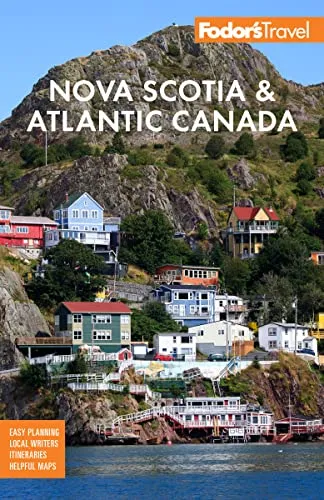Fodor's Nova Scotia & Atlantic Canada: With New Brunswick, Prince Edward Island & Newfoundland
Whether you want to visit Cape Breton Island, eat fresh lobster and mussels, or learn...
For many, Nova Scotia evokes images of seascapes. To the south and east, the Atlantic crashes against rocky outcrops or washes placidly over white sand. To the northwest, Fundy tides—the highest in the world—recede to reveal mudflats, then rush back in, raising the sea level by more than 50 feet. To the north, warm, relatively shallow Northumberland Strait flows between Nova Scotia and Prince Edward Island, providing a livelihood for fishermen on both sides. Nova Scotia is one of the world’s largest exporters of seafood, particularly lobsters. But the province is much more than its coastline alone; its coastal capital, Halifax, is a lively and attractive business and tourism hub.
It was Thomas Chandler Haliburton who first said "seeing is believing," and the observation applies to...
Read MoreFor many, Nova Scotia evokes images of seascapes. To the south and east, the Atlantic crashes against rocky outcrops or washes placidly over white sand. To the northwest, Fundy tides—the highest in the world—recede to reveal mudflats, then rush back in, raising the sea level by more than 50 feet. To the north, warm, relatively shallow Northumberland Strait flows between Nova Scotia and Prince Edward Island, providing a livelihood for fishermen on both sides. Nova Scotia is one of the world’s largest exporters of seafood, particularly lobsters. But the province is much more than its coastline alone; its coastal capital, Halifax, is a lively and attractive business and tourism hub.
It was Thomas Chandler Haliburton who first said "seeing is believing," and the observation applies to his home province because it's hard to fathom such a variety of cultures and landscapes packed into an area smaller than West Virginia without witnessing it firsthand. Within the perimeter drawn by that convoluted coastline, lie the rolling farmlands of the Annapolis Valley, which yields vintner’s grapes, apples, corn, peaches, and plums. In the middle of the province, dense forests are interspersed with blueberry patches, cranberry bogs, and, in spring and summer, open fields of wildflowers—purple and blue lupines, yellow coltsfoot, pink fireweed—that blanket the ground with color. In Cape Breton are highlands that rival Scotland's, rugged rock-rimmed inlets, woodlands that provide spectacular fall foliage, and mountains that plunge dramatically down to meet the waves. Throughout the province there is great biodiversity, including a number of endangered and threatened species that are being actively protected. In the western arm, the Southwest Nova UNESCO Biosphere Reserve, the second largest in Canada, includes the remote Kejimkujik National Park, which protects old-growth transitional woodland and all the wildlife that depends upon it.
The people of Nova Scotia are equally diverse. The original inhabitants, the Mi'Kmaqs, have been here for 10,000 years and remain a major cultural presence. In the early days of European exploration, they were joined by the French and English who settled on the shores and harvested the sea. Later, waves of immigrants came: Germans in Lunenburg County; Highland Scots displaced by their landlords' preference for sheep; New England Loyalists fleeing the American Revolution; freedmen or escaped slaves; then Ukrainians, Poles, West Indians, Italians, and Lebanese drawn to the industrial centers of Halifax and Sydney.
That multicultural mélange accounts for the fact that you’ll see Gaelic signs in Mabou and Iona, German sausage and sauerkraut prominently featured on menus in Lunenburg, and Francophones proudly flying their own tricolor flag in Acadian communities along the western Fundy coast and places such as Chéticamp in Cape Breton. It also helps explain why Nova Scotians, who originally hailed from so many different places themselves, are so famously hospitable to "people from away."
Find a Hotel
Top Destinations
Top Destinations

South Shore and Annapolis Valley

Cape Breton Island

Halifax

The Eastern Shore and Northern Nova Scotia

Lunenburg

Sydney

Wolfville

Annapolis Royal

Yarmouth

Baddeck

Chester

Mahone Bay

Cheticamp

Truro

Liverpool

St. Ann's Bay and Around

Tatamagouche

Parrsboro

Antigonish

Peggy's Cove

Pictou

Shelburne

Pointe de l'Église (Church Point)

Digby

Louisbourg

Windsor

Cape Chignecto and Cape d'Or

Mabou

Guysborough

Ingonish

Amherst

Long Island and Brier Island

Barrington and Cape Sable Island

Pleasant Bay

Cape North

Margaree Harbour

Kejimkujik National Park and Historic Site

Arichat

Sherbrooke and Sherbrooke Village

Five Islands

Springhill

Judique

Cape Breton Highlands National Park

Big Pond

Canso

Halifax

Lunenburg

Sydney

Wolfville

Annapolis Royal

Baddeck

Yarmouth

Chester

Mahone Bay

Cheticamp

Truro

Tatamagouche

Parrsboro

Liverpool

Antigonish

Peggy's Cove

Pictou

Shelburne

Pointe de l'Église (Church Point)

Digby

Louisbourg

Windsor

Mabou

Guysborough

Ingonish

Amherst

Cape North

Pleasant Bay

Inverness

Margaree Harbour

Arichat

Sherbrooke and Sherbrooke Village

Springhill

Judique

Big Pond

Canso
All Destinations
Expand All Collapse All
Top Experiences
Recent Forum Posts
Recent Forum Posts
-
W
Boston to Cape Breton Nova Scotia.
WarrenWST started Feb 21, 2024 |Last reply Mar 9, 2024 12 replies 903 views -
J
Would like help planning trip to Nova Scotia
Judilie started Nov 1, 2023 |Last reply Feb 16, 2024 15 replies 2623 views -
G
Planning a Nova Scotia trip mid September 2024
Glassmaker41 started Nov 1, 2023 |Last reply Nov 22, 2023 4 replies 1356 views -
S
Nova Scotia/PEI/Cape Breton 10 nights
Seemk started May 27, 2023 |Last reply Jun 6, 2023 10 replies 1356 views
Guidebooks
Guidebooks
Our worldwide travel correspondents bring you the best and most up-to-date coverage of over 7,500 global destinations.
Shop NowFodor's Nova Scotia & Atlantic Canada: With New Brunswick, Prince Edward Island & Newfoundland
Whether you want to visit Cape Breton Island, eat fresh lobster and mussels, or learn...








